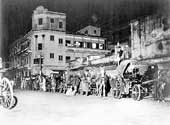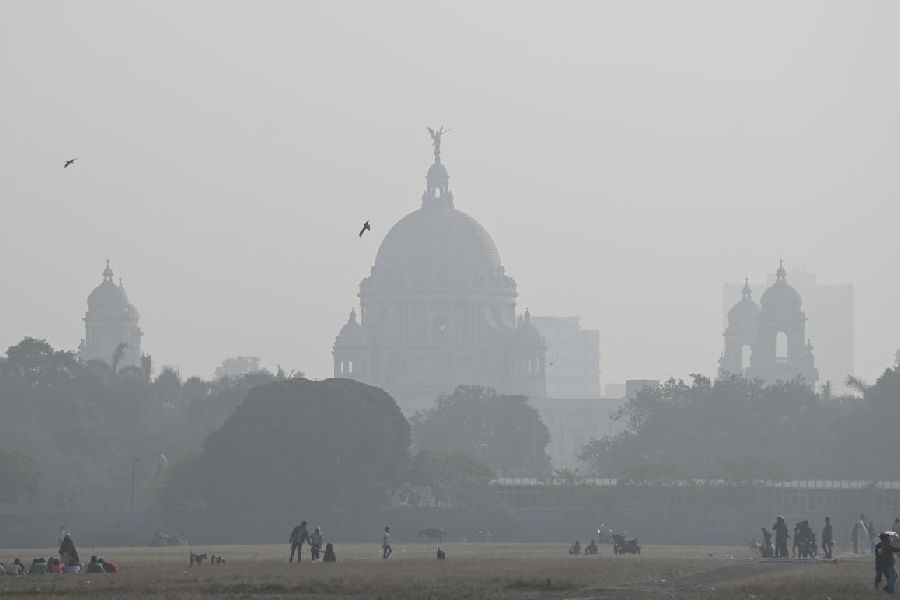 |
| Nightlife: A dimly lit “out-of-bounds” area in World War II Calcutta. A five-rupee ride in these “garies” would take one to a brothel. Photograph by Clyde Waddell. Picture courtesy Van Pelt Library, University of Pennsylvania |
Since 1941, Calcutta had lived under the shadow of a seemingly unstoppable Imperial Japanese Army. The city had become the headquarters of the Allied forces in the China-Burma-India theatre of the World War.
The Calcutta police force, first raised in 1856, consisted in 1939 of just over 9,000 men in 25 police stations and 10 specialist branches. It was modelled on London’s Metropolitan Police, but in practice, the Royal Irish Constabulary gendarmerie was emulated. To Indian eyes, it was part of the occupying forces of the Raj.
In the early development of policing in India, British NCOs from the East India Company’s European regiments (and later the regular British Army) were transferred to Indian police forces to maintain discipline and instruct them in foot and rifle drill and weapons-handling (quaintly called “musketry”). This is the origin of the rank of sergeant in today’s Calcutta police. In the imperial age “no native could arrest a European”. The power was restricted to sergeants and inspectors, who became, in effect, the “white man’s police” in India.
As most of the white men arrested were large, tough, belligerent and/or drunken European soldiers and sailors, the sergeants had to be equal to the task. In 1939, these large and physically hard British and Anglo-Indian policemen were trained by methods that owed more to the parade grounds of Aldershot and Catterick than the classrooms of Hendon. It was a tough job, whether clearing out brawling, white soldiers and sailors from public bars or leading a lathicharge into rioting mobs in Calcutta’s perennial communal disturbances.
In the war years, the sergeants of headquarter force maintained foot patrols in the centre of “European” Calcutta, Chowringhee Road from Dharamtollah to Park Street and the vicinities of the Spence’s, Great Eastern and Grand hotels. The mounted police patrolled the Maidan and the surrounds of Fort William in an arc from Government House to the southern suburb of Hastings, as far as Chitpore and Shyambazar.
Wartime Calcutta was a huge military transit camp as the Allies massed to engage the Japanese in Burma. The docks boiled with activity (and crime) as vast amounts of military ordnance poured in for Burma and nationalist China, supplied via the Ledo Road and the Herculean efforts of the East Bengal and Assam-Bengal Railways. Servicemen from all the Allied nations wandered the streets of the city’s centre (everywhere else was “out-of-bounds”) in search of “rest and recreation”, which usually consisted of a feed, a fight and sex (in any order). It was an unsafe age for women on their own. Rickshawpullers, hackney carriages and Sikh taxi drivers bore the brunt of assaults by “high-spirited” visiting forces.
Fort William was the Indian army’s HQ, Eastern Command, and the British army’s main transit camp sat in the central expanse of the Calcutta racecourse; the Royal Military Police office was on Corporation Street. The Ellenborough Polo Ground (between the south side of Fort William and Hastings) and the land between Red Road, Dufferin and Mayo Roads, were vast military vehicle parks. The 3.7” Vickers guns of a Royal Artillery heavy anti-aircraft battery banged away at raiding Japanese bombers from the roof of the Indian Museum and the Kidderpore Docks.
British and American military policemen and sergeants of the Calcutta police patrolled Calcutta’s main “night life” area to maintain order in a virtual cauldron of high tension caused by large numbers of restless men from every Allied nation who, in the circumstances, did not feel bound by any convention.
The Calcutta police were responsible for interning aliens from the Axis nations — including foreign sex workers from the European brothels in Karaya and the Japanese bordello in Watgunge. Adding to the complexity of the situation was the ongoing anti-British Quit India Movement and the simmering backdrop of communal tension.
The customary imperatives of policing prostitution, liquor-licensing offences and conventional crimes such as theft, robbery, criminal damage, fraud and assaults remained. Additional wartime tasks included detecting, monitoring and apprehending “Fifth Columnists” and recovering military deserters. Organised gambling, black-marketeering and breaches of the Rationing Regulations stretched the resources of the Enforcement and Security Control branches and the shadowy world of the Special Branch knew no rest. The criminal activities of Howrah’s self-styled “Scorpion Gang” — a motley collection of petty criminals — provided a brief distraction.
Keeping the peace was paramount; the alternative being an apocalyptic breakdown in law and order as evinced by the February Riots in 1946 and the even more cataclysmic Great Calcutta Killing (16th–20th August, 1946).
British officers of the Calcutta police were repatriating their families to England. The bulk of Anglo-Indian officers of every rank stood firm with their Indian colleagues, while insecure about their own legal status, unsure of their future. Indian senior officers were mainly ethnic Bengalis and most of them proved to be as competent as their British predecessors.
A fortnight after Independence Day, Calcutta experienced its first post-Independence communal riot. The Calcutta police maintained the stability of the city throughout while the fragile transition of power unfolded at the national level. In the receding aftermath of the Empire, the trickle of Anglo-Indian emigration became a flood and the majority of this community joined the world’s diaspora in seeking a new life in other lands.










